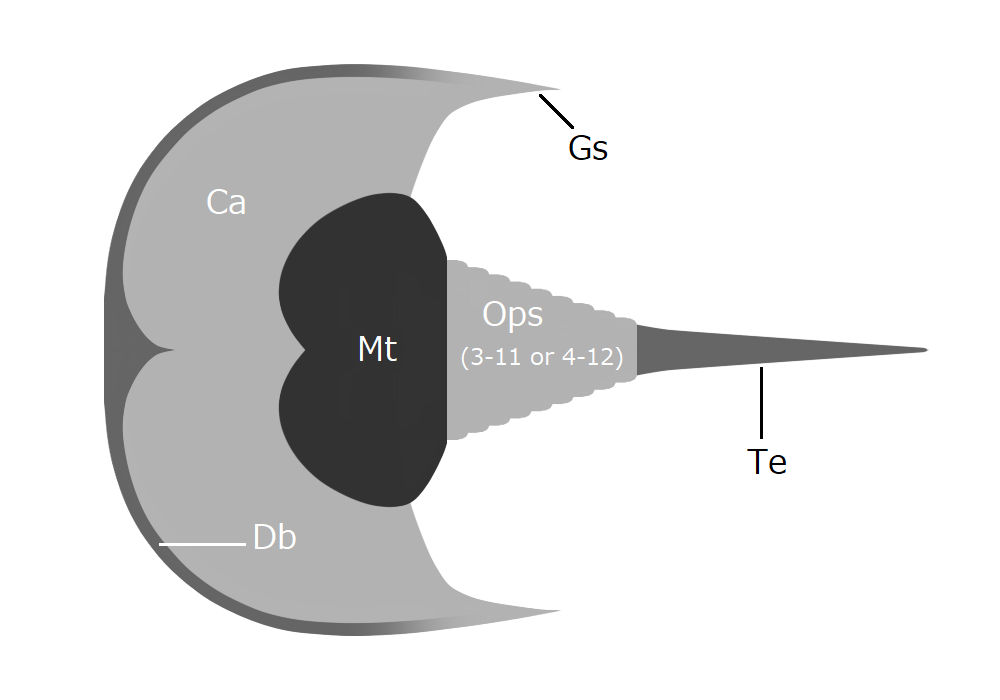Houia on:
[Wikipedia]
[Google]
[Amazon]
 ''Houia'' is an extinct genus of dekatriatan, a
''Houia'' is an extinct genus of dekatriatan, a
 ''Houia'' is an extinct genus of dekatriatan, a
''Houia'' is an extinct genus of dekatriatan, a clade
A clade (), also known as a monophyletic group or natural group, is a group of organisms that are monophyletic – that is, composed of a common ancestor and all its lineal descendants – on a phylogenetic tree. Rather than the English term, ...
of chelicerate
The subphylum Chelicerata (from New Latin, , ) constitutes one of the major subdivisions of the phylum Arthropoda. It contains the sea spiders, horseshoe crabs, and arachnids (including harvestmen, scorpions, spiders, solifuges, ticks, ...
arthropods. Fossils of ''Houia'' have been discovered in deposits of the Early Devonian
The Devonian ( ) is a geologic period and system of the Paleozoic era, spanning 60.3 million years from the end of the Silurian, million years ago (Mya), to the beginning of the Carboniferous, Mya. It is named after Devon, England, whe ...
period in Guangxi
Guangxi (; ; Chinese postal romanization, alternately romanized as Kwanghsi; ; za, Gvangjsih, italics=yes), officially the Guangxi Zhuang Autonomous Region (GZAR), is an Autonomous regions of China, autonomous region of the People's Republic ...
and Yunnan, both in China
China, officially the People's Republic of China (PRC), is a country in East Asia. It is the world's most populous country, with a population exceeding 1.4 billion, slightly ahead of India. China spans the equivalent of five time zones and ...
. The genus contains two species: ''H. guangxiensis'', from the Pragian
The Pragian is one of three faunal stages in the Early Devonian Epoch. It lasted from 410.8 ± 2.8 million years ago to 407.6 ± 2.8 million years ago. It was preceded by the Lochkovian Stage and followed by the Emsian Stage. The most important La ...
to Emsian epoch of Guangxi; and ''H. yueya'', the type species, from the Lochkovian epoch of Yunnan. The name of the genus is derived from the Chinese character 鲎 (''hòu''), meaning " horseshoe crab".
''Houia yueya'' was originally described as a species of the xiphosuran (horseshoe crab) genus '' Kasibelinurus'' (''Kasibelinurus yueya'') in 2013, with its narrow opisthosoma (the trunk section) being misinterpreted as incompletely preserved (lacking lateral regions). The species name ''yueya'' comes from the Chinese characters 月
Radical 74 or radical moon () meaning "moon" or " month" is one of the 34 Kangxi radicals (214 radicals in total) composed of 4 strokes.
In the ''Kangxi Dictionary''. there are 69 characters (out of 49,030) to be found under this radical.
is ...
(''yuè'', meaning " Moon") and 牙 (''yá'', meaning "crescent"), referring to the crescentic shape of its carapace
A carapace is a Dorsum (biology), dorsal (upper) section of the exoskeleton or shell in a number of animal groups, including arthropods, such as crustaceans and arachnids, as well as vertebrates, such as turtles and tortoises. In turtles and tor ...
(the dorsal plate of the prosoma or head).
''H. yueya'' was redescribed and replaced under its own genus, ''Houia'', in 2015, being reinterpreted as a basal ("primitive") dekatriatan possessing both horseshoe crab and eurypterid-like features (e.g. crescentic carapace for the former, and metastoma for the latter). Unlike most of dekatriatans like eurypterids and chasmataspidids, the metastoma
The metastoma is a ventral single plate located in the opisthosoma of non-arachnid dekatriatan chelicerates such as eurypterids, chasmataspidids and the genus ''Houia''. The metastoma located between the base of 6th prosomal appendage pair and m ...
(ventral plate in front of opisthosoma) of ''Houia'' is unusually enlarged, only being comparable by some mycteropoid
Mycteropoidea is an extinct superfamily of eurypterids, an extinct group of chelicerate arthropods commonly known as "sea scorpions". It is one of four superfamilies classified as part of the suborder Stylonurina. Mycteropoids have been recovered ...
eurypterids, and may have acted to crush more fortified prey. In 2021, a new species of ''Houia'', ''H. guangxiensis'', was described. Its species name derivates from the Chinese province in which it was discovered, Guangxi.
References
{{Reflist, 2 Dekatriata Early Devonian first appearances Devonian arthropods Fossils of China Fossil taxa described in 2015